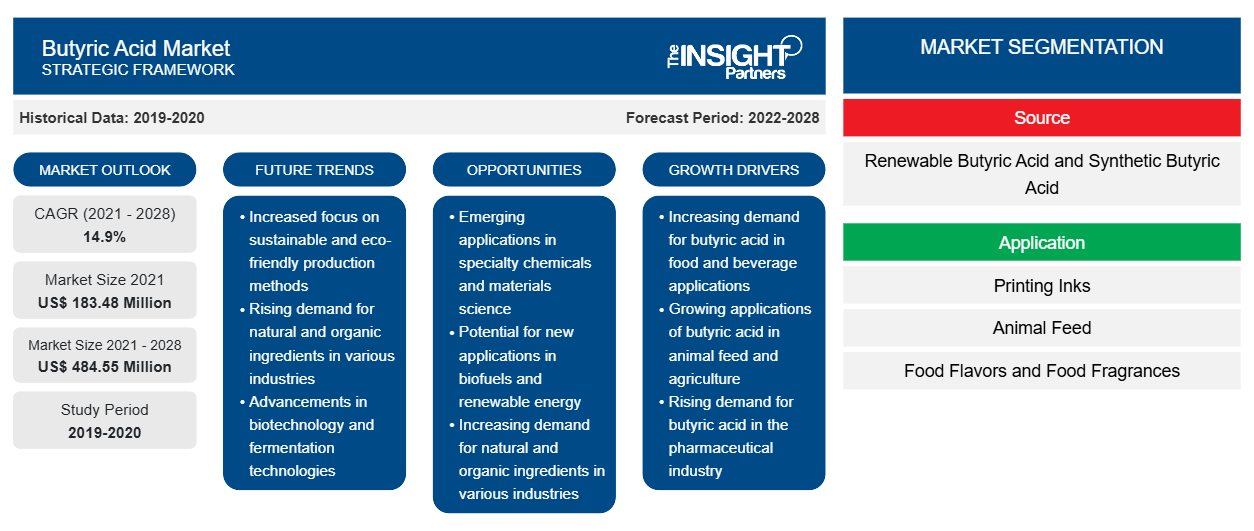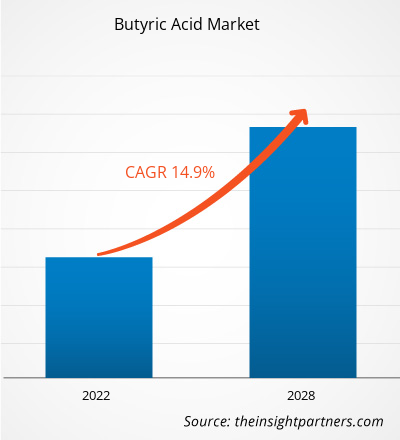Butyric Acid Market Growth and Analysis by 2028
Historic Data: 2019-2020 | Base Year: 2021 | Forecast Period: 2022-2028Butyric Acid Market Forecast to 2028 - COVID-19 Impact and Global Analysis By Source (Renewable Butyric Acid and Synthetic Butyric Acid) and Application (Printing Inks, Animal Feed, Food Flavors and Food Fragrances, Chemical Intermediates, Pharmaceutical, and Others)
- Report Date : Mar 2022
- Report Code : TIPRE00015611
- Category : Chemicals and Materials
- Status : Published
- Available Report Formats :


- No. of Pages : 159
The butyric acid market was valued at US$ 183.48 million in 2021 and is projected to reach US$ 484.55 million by 2028; it is expected to grow at a CAGR of 14.9% from 2021 to 2028.
Butyric acid is a colorless liquid with a penetrating and unpleasant odor. The acid has various important applications in chemical, food, and pharmaceutical industries. The butyric acid has many applications in the pharmaceutical industry.
In 2020, Asia Pacific held the largest revenue share of the global market. The growing number of livestock farms in Asia Pacific is increasing the consumption of animal feed and subsequently proliferating the butyric acid market. The growth in livestock farms in the Asia Pacific region can be attributed to the increased demand for quality meat products due the improving per capita income and growing health consciousness among consumers in the Asia Pacific region.
Customize This Report To Suit Your Requirement
You will get customization on any report - free of charge - including parts of this report, or country-level analysis, Excel Data pack, as well as avail great offers and discounts for start-ups & universities
Butyric Acid Market: Strategic Insights

-
Get Top Key Market Trends of this report.This FREE sample will include data analysis, ranging from market trends to estimates and forecasts.
Impact of COVID-19 Pandemic on Butyric Acid Market
The COVID-19 pandemic has adversely affected economies and industries in various countries due to lockdowns, travel bans, and business shutdowns. In 2020, various industries had to slow down their operations due to disruptions in value chains caused by the shutdown of national and international boundaries, which restricted the demand for butyric acid. The COVID-19 pandemic caused volatility in the prices of raw material required to produce butyric acid. The worldwide consumption of butyric acid declined due to low demand from various downstream sectors, such as food flavors, food fragrances, and chemical intermediates. The constraint availability of the raw materials and reduced demand from the downstream sectors due to COVID-19 pandemic have negatively impacted the growth of the butyric acid market.
Market Insights
Increasing Demand from Animal Feed Sector
Butyric acid is known for its beneficial effects on gut health and development. For decades, it has been in use in the animal feed industry for ensuring improved gut health and animal performance. Further, butyric acid has become a first-choice antibiotic alternative for broiler, layer, turkey, and swine producers with the animal feed industry’s shift to reduce antibiotic usage.
In recent years, the livestock industry in various countries has expanded rapidly with the shift in diet preferences among consumers toward animal proteins. Population growth, income surge, elevating living standards, and urbanization have been the key factors propelling the demand for meat worldwide. The increasing demand for meat products highlights the need for animal feed and feed additives. The growing demand for animal feed products in different regions boosts the demand for butyric acid, thereby bolstering the butyric acid market growth.
Butyric acid is one of the most beneficial short-chain fatty acids that plays a key role in uplifting digestive health, manages weight and prevents cancer. The strong growth in the pharmaceutical industry in different countries across the globe is leading to an increasing use of butyric acid for various applications. Furthermore, there is an increasing interest in using butyric acid as a precursor for producing biofuels. This is expected to offer lucrative opportunities for the growth of butyric acid market during the forecast period.
Source Insights
Based on source, the global butyric acid market has been segmented into renewable butyric acid and synthetic butyric acid. The synthetic butyric acid segment held a larger share in the global market in 2020. The synthetic butyric acid segment accounts for major share owing to its wide application for producing printing inks, disinfectants, flavors, medicines, perfumes, easters, and food additives among others.
Some of the players operating in the global butyric acid market includes, Eastman Chemical Company; OQ Chemicals GmbH; Tokyo Chemical Industry Co., Ltd.; Perstorp Holding AB; Alfa Aesar; MERCK KGaA; Vigon International, LLC.; Hefei TNJ Chemical Industry Co.,Ltd.; KUNSHAN ODOWELL CO.,LTD; and Yufeng International Co.,Ltd. Players operating in the butyric acid market focus on providing high quality products to fulfil the customer demand. These market players are highly focused towards the development of high quality and innovative services offerings to fulfil the customer’s requirements.
Butyric Acid Market Regional Insights
The regional trends and factors influencing the Butyric Acid Market throughout the forecast period have been thoroughly explained by the analysts at The Insight Partners. This section also discusses Butyric Acid Market segments and geography across North America, Europe, Asia Pacific, Middle East and Africa, and South and Central America.
Butyric Acid Market Report Scope
| Report Attribute | Details |
|---|---|
| Market size in 2021 | US$ 183.48 Million |
| Market Size by 2028 | US$ 484.55 Million |
| Global CAGR (2021 - 2028) | 14.9% |
| Historical Data | 2019-2020 |
| Forecast period | 2022-2028 |
| Segments Covered |
By Source
|
| Regions and Countries Covered |
North America
|
| Market leaders and key company profiles |
|
Butyric Acid Market Players Density: Understanding Its Impact on Business Dynamics
The Butyric Acid Market is growing rapidly, driven by increasing end-user demand due to factors such as evolving consumer preferences, technological advancements, and greater awareness of the product's benefits. As demand rises, businesses are expanding their offerings, innovating to meet consumer needs, and capitalizing on emerging trends, which further fuels market growth.

- Get the Butyric Acid Market top key players overview
Report Spotlights
- Progressive industry trends in the butyric acid market to help players develop effective long-term strategies
- Business growth strategies adopted by developed and developing markets
- Quantitative analysis of the butyric acid market from 2019 to 2028
- Estimation of global demand for HR-PIB
- Porter’s Five Forces analysis to illustrate the efficacy of buyers and suppliers operating in the industry
- Recent developments to understand the competitive market scenario
- Market trends and outlook as well as factors driving and restraining the growth of the butyric acid market
- Assistance in decision-making process by highlighting market strategies that underpin commercial interest, leading to the market growth
- The size of the butyric acid market size at various nodes
- Detailed overview and segmentation of the market, as well as the HR-PIB industry dynamics
- Size of the butyric acid market in various regions with promising growth opportunities
Global Butyric Acid Market
Source
- Renewable Butyric Acid
- Synthetic Butyric Acid
Application
- Printing Inks
- Animal Feed
- Food Flavors and Food Fragrances
- Chemical Intermediates
- Pharmaceutical
- Others
Company Profiles
- Eastman Chemical Company
- OQ Chemicals GmbH
- Tokyo Chemical Industry Co., Ltd.
- Perstorp Holding AB
- Alfa Aesar
- MERCK KGaA
- Vigon International, LLC.
- Hefei TNJ Chemical Industry Co.,Ltd.
- KUNSHAN ODOWELL CO.,LTD
- Yufeng International Co.,Ltd.
Frequently Asked Questions
What is the key driver for the growth of the global butyric acid market?
Which region is anticipated to grow with the fastest CAGR for the butyric acid market?
What is the impact of COVID-19 on the butyric acid market?
On the basis of application, which segment accounted for the largest share in the global butyric acid market?
Can you list some of the major players operating in the global butyric acid market?
During the forecast period, which region is anticipated to account for the largest share of the global butyric acid market?
Habi is a seasoned Market Research Analyst with 8 years of experience specializing in the Chemicals and Materials sector, with additional expertise in the Food & Beverages and Consumer Goods industries. He is a Chemical Engineer from Vishwakarma Institute of Technology (VIT) and has developed deep domain knowledge across industrial and specialty chemicals, paints and coatings, paper and packaging, lubricants, and consumer products. Habi’s core competencies include market sizing and forecasting, competitive benchmarking, trend analysis, client engagement, report writing, and team coordination—making him adept at delivering actionable insights and supporting strategic decision-making.
- Historical Analysis (2 Years), Base Year, Forecast (7 Years) with CAGR
- PEST and SWOT Analysis
- Market Size Value / Volume - Global, Regional, Country
- Industry and Competitive Landscape
- Excel Dataset
Recent Reports
Related Reports
Testimonials
The Insight Partners' SCADA System Market report is comprehensive, with valuable insights on current trends and future forecasts. The team was highly professional, responsive, and supportive throughout. We are very satisfied and highly recommend their services.
RAN KEDEM Partner, Reali Technologies LTDsI requested a report on a very specific software market and the team produced the report in a few days. The information was very relevant and well presented. I then requested some changes and additions to the report. The team was again very responsive and I got the final report in less than a week.
JEAN-HERVE JENN Chairman, Future AnalyticaWe worked with The Insight Partners for an important market study and forecast. They gave us clear insights into opportunities and risks, which helped shape our plans. Their research was easy to use and based on solid data. It helped us make smart, confident decisions. We highly recommend them.
PIYUSH NAGPAL Sr. Vice President, High Beam GlobalThe Insight Partners delivered insightful, well-structured market research with strong domain expertise. Their team was professional and responsive throughout. The user-friendly website made accessing industry reports seamless. We highly recommend them for reliable, high-quality research services
YUKIHIKO ADACHI CEO, Deep Blue, LLC.This is the first time I have purchased a market report from The Insight Partners.While I was unsure at first, I visited their web site and felt more comfortable to take the risk and purchase a market report.I am completely satisfied with the quality of the report and customer service. I had several questions and comments with the initial report, but after a couple of dialogs over email with their analyst I believe I have a report that I can use as input to our strategic planning process.Thank you so much for taking the extra time and making this a positive experience.I will definitely recommend your service to others and you will be my first call when we need further market data.
JOHN SUZUKI President and Chief Executive Officer, Board Director, BK TechnologiesI wish to appreciate your support and the professionalism you displayed in the course of attending to my request for information regarding to infectious disease IVD market in Nigeria. I appreciate your patience, your guidance, and the fact that you were willing to offer a discount, which eventually made it possible for us to close a deal. I look forward to engaging The Insight Partners in the future, all thanks to the impression you have created in me as a result of this first encounter.
DR CHIJIOKE ONYIA MANAGING DIRECTOR, PineCrest Healthcare Ltd.Reason to Buy
- Informed Decision-Making
- Understanding Market Dynamics
- Competitive Analysis
- Identifying Emerging Markets
- Customer Insights
- Market Forecasts
- Risk Mitigation
- Boosting Operational Efficiency
- Strategic Planning
- Investment Justification
- Tracking Industry Innovations
- Aligning with Regulatory Trends




















 Get Free Sample For
Get Free Sample For